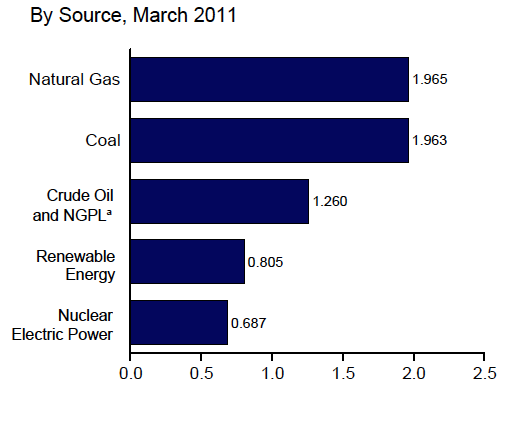Renewables overtake nuclear power generation in U.S.

Renewable energy is no longer the underdog amid the national energy mix. Clean power production in the United States crossed a major milestone in January, exceeding the amount of electricity generated by nuclear facilities.
A monthly report published by the U.S. Energy Information Administration (EIA), a statistical and analytical agency within the U.S. Department of Energy, shows how renewable energy sources narrowly out produced nuclear power during the first three months of the year (Table 1.2).

Biomass and hydroelectric power were the two largest sources of renewable power. Those were trailed by wind, geothermal, and solar power, respectively. Forbes creditsheavy spring rains in California, Oregon, and Washington for a 52.2 percent surge in hydroelectric power generation.
The last time that renewable electricity surpassed nuclear power generation was at a brief point in the mid-nineties; otherwise, nuclear energy has led renewables for most of the past decade.
Venture capitalists have suggested that renewable energy technologies are reaching grid parity for the first time, and General Electric has predicted that solar power will soon become more affordable than fossil fuels and nuclear generated power.
Last month, Ernst & Young forecasted that prices of solar panels would plunge to $1.00 per watt. Research published by IHS iSuppli published a week earlier came to the same conclusion.
Global clean energy investment increased by 32 percent in 2010 to a total of US$211 billion, according to the United Nations. Most of that growth occurred in China and Europe to finance wind and solar projects.
U.S. Venture capital firms invested over $1 billion into renewables during the last quarter of 2010 alone, and there has been a growing financial commitment from stakeholders in the private sector such as Google.
Historically, renewables held a lengthy lead over nuclear power throughout the 70’s and into the 1980’s. Then the production of nuclear electric power rose dramatically from mid 70’s onward, but has since plateaued as renewables have been further developed.
It is likely that nuclear power’s percentage of the energy mix will creep upward as well. The federal government is spending billions in subsidies to construct next generation nuclear reactors.
The EIA report also reveals a slight uptick in natural gas-fired power generation and a potential trend away from coal. Northeastern states including Pennsylvania, which has vast reserves of natural gas, led gas-fired generation.
Those states sit atop expansive shale gas reserves, which are being tapped through a controversial mining practice called hydrofracking. The national energy mix is changing, but that change is occurring gradually - for the time being.
Photo: Esther Harlow/Flickr
Related on SmartPlanet:
- America's nuclear future
- Scientists: nuclear power isn't viable without corporate welfare
- Google's clean energy investments nearing US$1 billion
- Green tech VC funding stabilizes over $1 billion
- Green tech moves to the top of the class at Wharton
- GE says fossil fuels, nuclear soon costlier than solar
This post was originally published on Smartplanet.com
